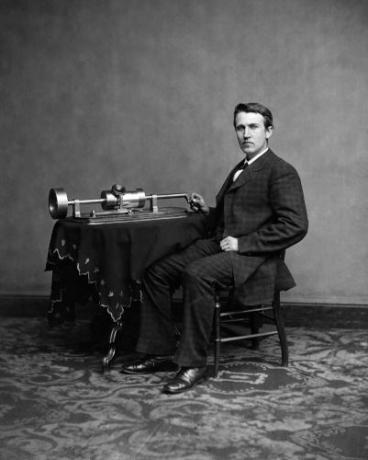ThomasEdison was an American inventor and businessman who prospered through his work. He got rich with patents for his inventions and was marked by improving the telegraph and inventing the phonograph, the cinematograph and the incandescent lamp.
Accessalso: Isaac Newton — one of the most important physicists in history
Thomas Edison Summary
Thomas Edison dropped out of school after attending it for a few months and was educated by his mother.
He started working at age 12 selling sweets and newspapers at a train station.
He devoted himself to his inventions from the 1860s onwards and registered over 2000 patents throughout his life.
He invented the incandescent lamp, one of his major works, in 1879.
He was married twice and had six children.
firstThomas Edison years
ThomasalbEdison was born in the city of Milan, in Ohio, in the U.S, on February 11, 1847. he was the son of Nancy Elliott, a kindergarten teacher, and Sam Edison Jr., a joiner. The couple had seven children, with Thomas Edison being the youngest of them, and of the seven, four reached adulthood.
When he was seven years old, his family moved to Port Huron, Michigan. There, he spent part of his childhood and had access to a short period of going to school. He had some difficulties in his studies, mainly because his teacher didn't have the patience to answer his doubts.
So his mother stopped him from going to school, and she taught him at home herself. It was studying at home that Thomas Edison developed an enormous curiosity about technology and science. His curiosity made him set up, in his own house, a small laboratory, where he carried out chemical experiments.
A fact that marked his life was the loss of your hearing, when he was 12 years old. He was deaf in one ear and had very limited hearing in the other, which is attributed to the complications of scarlet fever and possible ear infections that have not been properly treated.
Thomas Edison's Professional Career
Thomas Edison started working when he was practically still a child, because, at age 12, he started to sell candy and newspapers at a train station connecting Port Huron to Detroit. With the money he earned, he financed his laboratory and continued to carry out chemical and electrical experiments. In 1862 he learned to operate the Telegraph, important communication device of the time.
Learning to operate a telegraph was important because it allowed him to hold jobs for a considerable period of time. Between 1863 and 1868, Thomas Edison worked as a telegraph in different North American cities, until he settled in Boston.
Thomas Edison's Inventions

From 1868, Thomas Edison dedicated himself to his first invention — a device that registered votes. He patented the invention in 1869, but it was not commercially successful. That same year, he moved to New York and decided to work on inventing an electrical device that would record the price of stock exchanges. This invention was sold by him, for 40 thousand dollars, to Western Union.
This money allowed him to settle in Newark, outside New York, and set up his own laboratory. From 1871, Thomas Edison was fully dedicated to the development of new inventions and the telegraph improvement. His aim was to develop a mechanism that would allow the telegraph to send two messages at the same time, and that aim was achieved in 1874.
Thomas Edison managed to prosper with his inventions and patents, and with this he opened, in 1876, a new laboratory, in Menlo Park, in the state of New Jersey. There, he performed numerous inventions and perfected a number of other equipment at the time.
His inventiveness made him known as the FsorcererinMenlopark. Two standout inventions from that moment in his life were the phonograph and the lampincandescent. The first was a device that could record and reproduce sounds and was invented in 1877; the second, created in 1879, operated on electrical energy, a feat he achieved by placing a charred cotton filament inside a vacuum glass bulb. He plugged the bulb into electrical power, and the filament stayed on for 40 hours.
Thomas Edison also devoted his time to perfecting his inventions and other equipment at the time. In addition to patenting his inventions, he also founded a number of companies working in different fields. The main ones worked in the field of electrical energy, such as the Edison Electric Light Company, the Edison Illuminating Company and General Electric. He also managed to open branches of his companies in Europe.
In the late 19th century, Thomas Edison became involved in what became known as “warof thechains”, a dispute fought with Nikola Tesla to decide which current of electrical energy would predominate in the distribution of energy in the United States. Edison advocated direct current and Tesla, alternating current. In that dispute, that one was defeated.
Thomas Edison was also responsible for inventions such as:
mimeograph: machine responsible for making copies of documents;
cinématographe: machine responsible for capturing moving images;
kinescope: device capable of reproducing video images.
Accessalso: Benjamin Franklin and his studies on electricity
Thomas Edison's Personal Life
Despite being a very busy man, Thomas Edison devoted part of his time to raising a family, although he spent much of the day away from home working. In 1871 he married maryStilwell, and with her he had three children. This first wife died in 1884, and it is speculated that her death was the result of brain cancer or an overdose of morphine. In 1886, the inventor remarried, and his second wife was named MineMiller, with whom he stayed until his death. From the second marriage, three children were also born.
read more: Marie Curie — demonstrated the existence of natural radioactivity and discovered two chemical elements
Thomas Edison's Last Years
Thomas Edison remained active in his business throughout his life, and it was not until the 1920s that his health began to deteriorate. THE diabetes played a big part in this, and in the last two years of his life he had several problems caused by it.
On October 14, 1931, Thomas Edison became ill and went into a coma, and in october 18th of 1931, died at 84 years of age. He was marked as one of the most inventive men in the history of mankind, and his inventions contributed to the great technological development of the 20th century.
Thomas Edison received several honors in life for his achievements, and ended his journey being owner of more than two thousand patents, a demonstration of their ingenuity.
by Daniel Neves
History teacher
Source: Brazil School - https://brasilescola.uol.com.br/biografia/thomas-edison.htm


